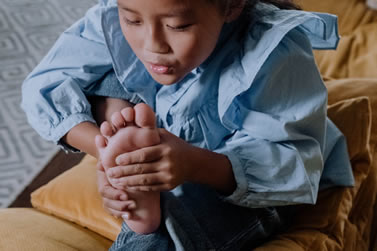 Treating Calcaneal Apophysitis (Sever’s Disease) In Children
Treating Calcaneal Apophysitis (Sever’s Disease) In Children
Heel pain can really interfere with the comfort of your daily routine, especially if you’re a kid! But did you know that kids actually have a higher propensity for developing heel inflammation than adults? The most common cause of heel pain in children is Calcaneal Apophysitis, also known as Sever’s Disease. Contributors to the condition primarily include increased athletic activity. And there’s no way to “cure” it. So, what can you do to treat Calcaneal Apophysitis? Read on to learn!
What is Calcaneal Apophysitis?
Calcaneal Apophysitis, also known as Sever’s Disease, is a condition unique to children. It is defined as pain and inflammation in the heel due to overuse, strain or pressure. It is the most common form of heel pain in children and adolescents. Inflammation in the heel is caused by repetitive stress at the heel’s growth plate. Because a child’s heel bone continues to develop up until about the age of 14, repeated stress on the area, typically through increased activity and sports, can cause painful inflammation.
Who is at risk of Calcaneal Apophysitis?
Calcaneal Apophysitis affects children between the ages of about 8-14. These are the dominant years when the heel bone is experiencing a growth spurt: when the bones, tendons and muscles are going through rapid transition.
The “growth plate” is actually an area of cartilage located at the end of a bone. Once the area is finished developing, it’s replaced by hardened bone. Until then, the area is in a weakened state and susceptible to harm. This is what predisposes children and adolescents to heel pain. What they are experiencing is inflammation at the heel’s growth plate when excessive stress is placed on the heel. This happens most commonly due to increased activity, such as playing sports, but can also be cause by excessive weight. In addition to heel pain, nearby tendons and ligaments are also vulnerable to trauma until the growth plate matures into hardened bone.
Because the heel is also located at the attachment point of the Achilles Tendon, the pulling of the Achilles Tendon can also exacerbate pain in the area. Other potential causes of calcaneal apophysitis include obesity, a tight Achilles Tendon and biomechanical problems, such as flatfoot or a high-arched foot.
Calcaneal Apophysitis can happen on one or both heels, and will continue to reoccur if treatments aren’t sought. The good news is, there are ways to manage the pain and inflammation and prevent the condition from recurring until the heel has matured. Once the heel bone is solidified, the condition will go away on its own. Until then, there are ways to manage the symptoms.
Symptoms of Calcaneal Apophysitis:
- Heel Pain
- Heel Swelling
- Heel Tenderness
- Difficulty walking or running
- Walking on toes
Diagnosing Calcaneal Apophysitis:
The best way to know if your child has Calcaneal Apophysitis is to visit your family podiatrist. There, they can do a diagnostic exam to understand why your child is having heel pain. The doctor will do a physical examination of the foot and heel and ask some lifestyle questions. If needed, they may also take an x-ray or prescribe advanced imaging technology to help better diagnose the issue and the severity of the condition.
How to Treat Calcaneal Apophysitis:
Your podiatrist may recommend resting your feet for days, weeks or even months in some cases, followed by targeted strength and conditioning exercises. Heel pads or custom orthotics can help absorb the impact of running and walking, thus relieving stress on the heel. Wearing shoes with a slightly elevated heel may also help relieve pain. You may also consider taking nonsteroidal anti-inflammatory medication to reduce stress and pain in the area.
For more severe cases, your podiatrist may recommend a walking boot to help temporarily restrict range of motion, which also helps reduce inflammation.
Here is a synopsis on what you can do to help relieve the symptoms of Calcaneal Apophysitis:
- Rest the heel by reducing activity
- Support the heel with custom orthotic inserts
- Nonsteroidal pain-relieving medications
- Stretching or Physical Therapy
- Walking Boot to relieve pain and inflammation
If you’re concerned your child is suffering from Calcaneal Apophysitis, we encourage you to give us a call to set up an in-office diagnostic appointment. To schedule an appointment with Dr. Garzon at County Wide Foot, Ankle & Wound Care in Boynton Beach, Florida, call 561-369-3300.
